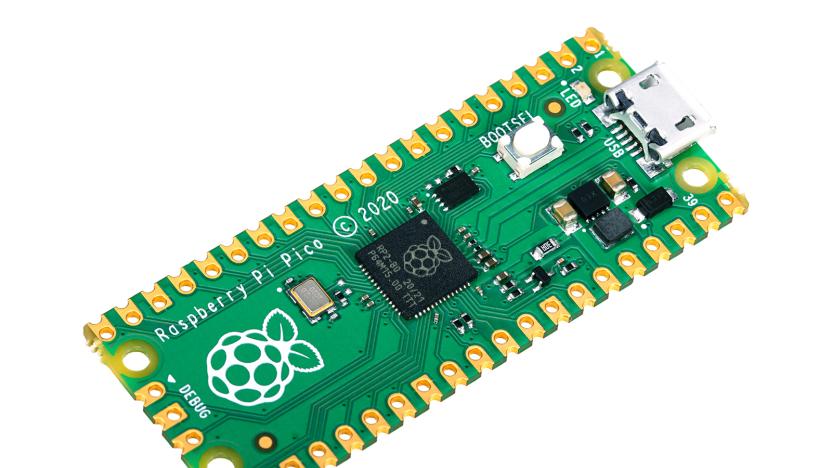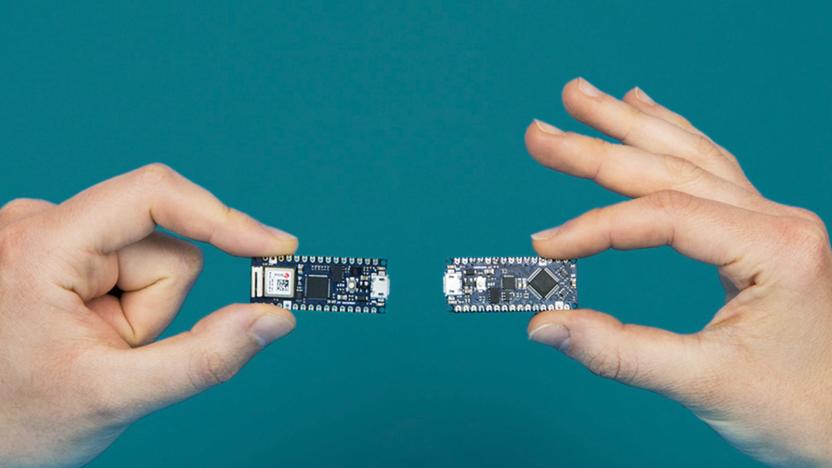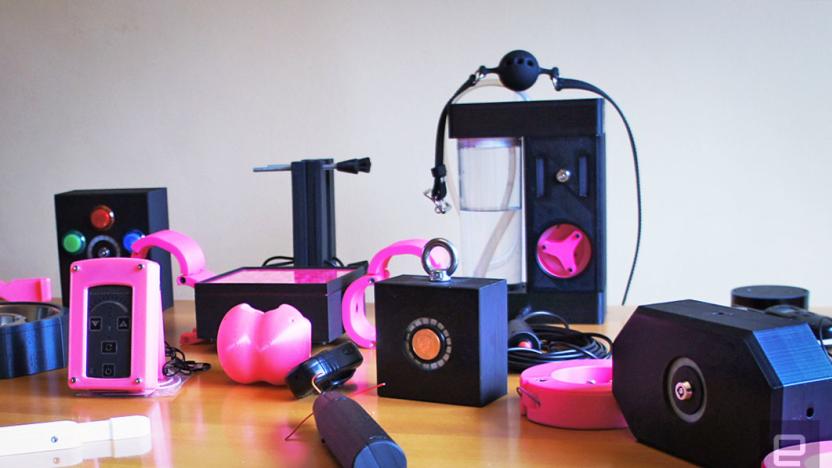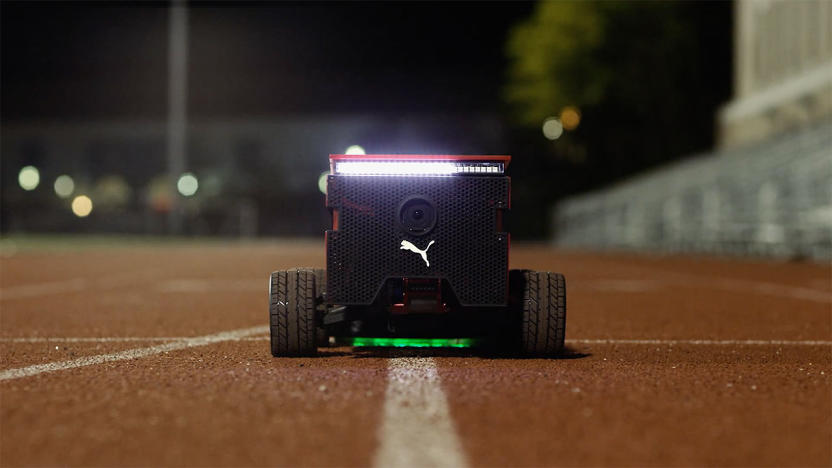arduino
Latest

Raspberry Pi Pico is a $4 Arduino alternative
The Raspberry Pi team has released the Pico, a $4 microcontroller that competes with Arduino.
Jon Fingas01.21.2021
Daisy is a tiny $29 computer for building custom musical instruments
Coding your own musical instruments just got a lot more convenient. Music tech company Electrosmith has launched the Daisy, an open source microcomputer packed with everything you need to code your own pedals, synth, modules and instruments -- and it's the size of a stick of gum.
Rachel England02.27.2020
You can make your own rotary cellphone
As convenient as modern cellphones are, there's a certain charm to spinning an old-fashioned rotary dial to make a call -- and now, there's a cellphone that caters to that nostalgia. Brookhaven National Lab engineer Justine Haupt has developed a rotary cellphone that's not only functional, but available to make with the help of a $240 do-it-yourself kit. It's effectively a throwback to the days when phones were for calling and nothing else, plus a few present-day creature comforts.
Jon Fingas02.17.2020
Arduino's new Nano board family is more powerful and affordable
Arduino's Nano line will soon welcome four new products. They're all small boards like the classic one, making Nano a family of small boards meant for compact projects. All the new boards boast low energy consumption and processors more powerful than what the classic has. Even better, they're all pretty affordable: the most basic entry called Nano Every, which you can use for "everyday" projects and can replace the classic Nano, will even set you back as little as $9.90.
Mariella Moon05.18.2019
RVR is a Sphero robot for budding tinkerers
Sphero's been amusing us with its collection of robotic balls, like its adorable BB-8, for eight years. But lately the company has been getting away from the toy aspect of its products and embracing its educational potential. It's had an app that can be used to program many of its current bots for a while now, but that's only for budding coders — what do kids interested in hardware have to tinker with? Indeed, Sphero is about to release its first robot specifically made to be physically modded, called the RVR.
Kris Naudus02.19.2019
There’s no limit to the connected sex toys you can build at home
NSFW: This article contains links to and descriptions of explicit sexual acts including BDSM play that some may find uncomfortable. The individuals included in this report are consenting adults who observe proper safety procedures in their play. The voice-enabled Mistress Alexa may be Deviant Designs' most famous creation yet, but it's only one of a fleet of smart sex toys that its creators have dreamed up. British couple Gary and Kirsty are building new smart devices for BDSM play on a monthly basis. Thanks to Arduino hardware and a 3D printer, there are few limits to what can be achieved with a little practice. I toured some of the other adult toys made in the last year.
Daniel Cooper05.09.2018
Netflix becomes your personal trainer with its new DIY device
Working out can be tough, but inversely, watching Netflix is super easy. The streaming giant doesn't want to distract you from your fitness goals, though. Netflix would much rather be your workout buddy, which is why it posted instructions for making a DIY personal trainer gadget.
Derrick Rossignol03.01.2017
ICYMI: CERNs robotic inspectors ride a monorail
try{document.getElementById("aol-cms-player-1").style.display="none";}catch(e){}Today on In Case You Missed It: Pairing an Arduino with a skateboard produces the Sick Ollie Machine, capable of measuring angular and X-,Y- or Z-axis accelerations to measure who is hitting their tricks the hardest. Courtesy of Josh Sheldon, the ollie machine uses an Arduino beneath the trucks of the board paired with a relay to measure the stats of each trick. Those who are producing truly sick ollies are rewarded with a chime from the attached cowbell. Meanwhile, over at CERN a set of robot twins have been enlisted to provide live video feeds and environmental measurements for the massive underground complex. The robots, called TIM twins for Train Inspection Monorail, move along a -- you guessed it -- overhead rail that runs throughout the facility in order to monitor stats like oxygen concentration and radiation emissions. Also, don't forget to check out what happens when a frog is run through Google's Deep Dream project (which is easily the weirdest sentence I've written yet today). As always, please share any interesting tech or science videos you find by using the #ICYMI hashtag on Twitter for @mskerryd.
Amber Bouman11.29.2016
Smart ping pong paddles remix music to the speed of play
I love playing table tennis, but my backhand topspin is average at best. I'll play for an hour and grow tired of chasing wayward balls, knowing that I'll never have a smash quite like Peco from Ping Pong. Never mind -- now I can cut loose with a game of "Ping Pong FM" instead. The modified bats, which have contact microphones inside, log when you've hit the ball and remix music accordingly. Exchange slices too slowly and the song will drop to a lower tempo; likewise, driving the ball with some vicious top spin will cause it to speed up. You can try to match the beat or purposefully remix the music in weird and wonderful ways -- it's entirely up to you.
Nick Summers10.17.2016
Arduino is making an Internet of Things kit with your help
Arduino boards can certainly be used to create homebrew connected devices, but that doesn't mean it's easy. What if you're a rookie who has yet to master programming or wiring? That's where Arduino's new, crowdfunded ESLOV kit might save the day. All you have to do to create a basic Internet of Things device is snap in some plug-and-play modules, connect your creation to your PC and draw connections between those modules in an editor. You only have to dive into serious programming if you have specific needs -- there's ready-made code for common devices like air quality sensors, baby monitors and remote-controlled thermostats.
Jon Fingas09.28.2016
Build your own Lego drone with these affordable kits
Lego bricks have been the foundation of so many awesome and elaborate creations, it's no wonder people have already had the idea to send them skyward in drone form. But while there are plenty of DIY tutorials around, as well as the odd prebuilt model, we haven't seen anything quite as accessible and affordable as these new Lego UAV kits from Flybrix.
Jamie Rigg09.22.2016
Real-world 'Pong' might just beat the video game
If you miss the days of playing Pong with old-school dial controllers but would rather not track down a vintage console or arcade cabinet, today's your lucky day. Daniel Perdomo and crew have built a real-world Pong machine that replicates the pioneering game with physical parts. Despite what it looks like, it's not just an Atari-themed air hockey table. Instead of letting physics take over, the machine maps virtual ball and paddle movements to objects. All the eccentricities of Pong gameplay are intact, just in a more tangible (and arguably, far more immersive) form. LEDs track the score, while the controllers are rejiggered hard drives.
Jon Fingas05.30.2016
Google Science Journal studies the world through your phone
Are you (or your kid) curious about the world around you? Google wants to help. It just launched Science Journal, an Android app that helps you perform (and comment on) simple science experiments. The app can record light, motion and sound levels using only your phone's sensors, letting you study everything from a light bulb's brightness to the acceleration in a jump. It's easy to kick things up a notch, though. You can connect Arduino-powered sensors, and Google is partnering with Exploratorium to offer starter kits to help budding scientists. Science Journal is free, so there's no harm in giving it a try -- even if you're a full-fledged adult, you might learn something.
Jon Fingas05.22.2016
Puma's robotic running companion can keep pace with Usain Bolt
For some people, the RunKeeper coach's voice is enough to keep them motivated during a jog. Others need something physical to keep pace with. That's where Puma's BeatBot comes in. Developed by a NASA robotics engineer, a trio of MIT students and Puma's ad agency, the robot follows lines around a track at any pace you'd want, according to Fast Company. It can even match Usain Bolt's 2009 foot-speed world record of 44.6 KPH (27.7 MPH) in case you need something a little more aspirational than an eight-minute mile.
Timothy J. Seppala04.30.2016
Antbo is a robot insect companion anyone can build
Interested in building and programming your own robot? You might want to give Antbo a try. Billed as the "insect robot designed for anyone with an inquisitive mind," it's a programmable entry-level kit for beginners or anyone with a casual interest in robotics.
Brittany Vincent04.20.2016
Arduino clone is as small as an AA battery
What do you do if even the smallest Arduino boards (or their clones) are too big for your homebrew project? If you're Johan Kanflo, you find a way to make them even smaller. His AAduino project turns the already miniscule Tiny328 Arduino clone into an even smaller computing device that's about as big as an AA battery. Through creative wiring, it even fits inside a typical battery holder and draws power from the batteries in the remaining slots. He had to underclock the processor to extend to the battery life, but it's otherwise as capable as its normal counterparts.
Jon Fingas04.20.2016
Engadget giveaway: Win an mCookie Family Kit courtesy of Microduino!
Getting your STEM skills up to speed is now easier than ever with Microduino's mCookie. These Arduino-compatible electronics kits make building mini machines a snap -- literally -- with magnetic connectors and interlocking pins that match up with LEGO blocks. The mCookie family of DIY modules, sensors and accessories was Kickstarted back in 2015 and began shipping to consumers at the end of the year. Now anyone can pick up one of the various kits (Basic, Advanced or Expert) and assemble projects like a music box, voice-activated camera, paw-waving fortune cat and more. Microduino also offers additional components to expand the possibilities to keep pace with your imagination. This week, one lucky reader will win a Family Kit (including all three mCookie sets) to launch their smart-machine-making career. Just head down to the Rafflecopter widget below for up to three chances at winning. Winner: Congratulations to Robin B. of Chico, CA!
Jon Turi03.22.2016
Machine turns your Twitter posts into tasty cocktails
Ever wondered what your tweets would taste like if you could distill them into a drink? Probably not, but there's now a way to find out. Clément Gault and Koi Koi Design have whipped up Data Cocktail, an Arduino-powered machine that creates a drink based on Twitter updates. In its current incarnation, it looks for the five latest tweets mentioning keywords linked to ingredients, and fills the glass accordingly. The result is an original, spur-of-the-moment mix -- it'll even print out the 'recipe' (really, a ratio of the keywords) and thank the users who unwittingly contributed to the beverage.
Jon Fingas02.10.2016
ICYMI: Cockroach torture, an app for Parkinson's and more
#fivemin-widget-blogsmith-image-567613{display:none;} .cke_show_borders #fivemin-widget-blogsmith-image-567613, #postcontentcontainer #fivemin-widget-blogsmith-image-567613{width:570px;display:block;} try{document.getElementById("fivemin-widget-blogsmith-image-567613").style.display="none";}catch(e){} Today on In Case You Missed It: A cybernetic cockroach how-to describes how to use an Arduino to control where a cockroach goes, which makes all of us uncomfortable.
Kerry Davis02.03.2016
Engadget giveaway: Win a pair of Vortex robots courtesy of DFRobot!
Since most kids have already mastered the art of iPad password cracking and in-app purchasing, we should probably give them something productive to do. The arduino-based Vortex from DFRobot is a STEM-reinforcing plaything that can help kids learn to code. It comes with preinstalled programs, so you can have fun racing, bumping and spinning right out of the box, but the variations are endless. Open-source hardware and the WhenDo app's graphical programming interface mean the sky's the limit with Vortex. These little bots are laden with proximity and ground sensors, LEDs and speakers — not to mention all the optional add-ons — to help bring them to life. DFRobot has given us a pair of two-robot packs for a couple lucky Engadget readers this week. All you need to do is head to the Rafflecopter widget below for up to three chances at winning this hackable robot duo.
Jon Turi01.19.2016